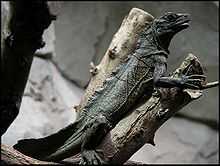Hydrosaurus amboinensis
| Hydrosaurus amboinensis | |
|---|---|
 | |
| At the Houston Zoo | |
 | |
| Scientific classification | |
| Kingdom: | Animalia |
| Phylum: | Chordata |
| Class: | Reptilia |
| Order: | Squamata |
| Suborder: | Lacertilia |
| Family: | Agamidae |
| Subfamily: | Hydrosaurinae |
| Genus: | Hydrosaurus |
| Species: | H. amboinensis |
| Binomial name | |
| Hydrosaurus amboinensis (Schlosser, 1768)[1] | |
The Amboina sail-finned lizard or Amboina sailfin lizard[1] (Hydrosaurus amboinensis) [2] is the largest agamid lizard in the world, growing to over one metre in length. It is found in Papua New Guinea, Indonesia,[1] and the Philippines.[3] Due to confusion with H. pustulatus, its exact distribution in the Philippines is uncertain, but northern populations are generally considered H. pustulatus and southern considered H. amboinensis.[4] This lizard is able to run short distances across water using both its feet and tail for support, an ability shared with the plumed basilisk.
References
- ↑ 1.0 1.1 1.2 Hydrosaurus amboinensis, The Reptile Database
- ↑ Zipcode zoo.com
- ↑ Herpwatch.org
- ↑ Ledesma, M., Brown, R., Sy, E. & Rico, E.L. (2007). "Hydrosaurus pustulatus". IUCN Red List of Threatened Species. Version 2011.1. International Union for Conservation of Nature.
Further reading
- Bleeker, P. (1860). [12. Reptilien van Boni]. Natuurkundl. Tijdschr. Nederl. Indie, Batavia 22: 81-85
- Boulenger, G.A. (1885). Catalogue of the Lizards in the British Museum (Nat. Hist.) I. Geckonidae, Eublepharidae, Uroplatidae, Pygopodidae, Agamidae. London: 450 pp.
- Das, I. (1993). Jour. Sarawak Mus., 44 (65): 128
- De Rooij, N. de (1915). The Reptiles of the Indo-Australian Archipelago. I. Lacertilia, Chelonia, Emydosauria. Leiden (E. J. Brill), xiv + 384 pp.
- Duméril, A. M. C. and G. Bibron. (1837). Erpétologie Générale ou Histoire Naturelle Complete des Reptiles. Vol. 4. Libr. Encyclopédique Roret, Paris, 570 pp.
- Gábris, J. (2003). Zur Haltung von philippinischen Segelechsen (Hydrosaurus pustulatus). Draco 4 (14): 24-33
- Gray, J. E. 1845. Catalogue of the specimens of lizards in the collection of the British Museum. Trustees of die British Museum/Edward Newman, London: xxvii + 289 pp.
- Günther,A. 1873. Notes on some reptiles and batrachians obtained by Dr. Bernhard Meyer in Celebes and the Philippine Islands. Proc. Zool. Soc. London 1873: 165-172
- Manthey,U. & SCHUSTER,N. 1999. Agamen, 2. Aufl. Natur und Tier Verlag (Münster), 120 pp.
- Peters, Wilhem Carl Hartwig 1872. Über einige von Hrn. Dr. A. B. Meyer bei Gorontalo und Auf den Togian-Inseln gesammelte Amphibien. Monatsber. königl. Akad. Wiss. Berlin. 1872 (Juli): 581-585
- Poche, F. 1903. Einige nothwendige Änderungen in der herpetologischen Nomenklatur. Zool. Anz. 26: 698-703
- Schlosser 1768. Epistola ad F. DEJEAN de L. amboin.
- Shaw, G. 1802. General Zoology, or Systematic Natural History. Vol.3, part 2. G. Kearsley, Thomas Davison, London: 313-615
- Werning, H. (2004). Bibliographie der Gattungen Physignathus, Lophognathus und Hydrosaurus. Iguana Rundschreiben 17 (2): 18-31